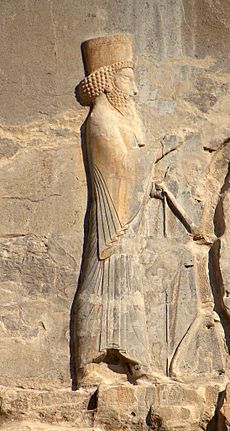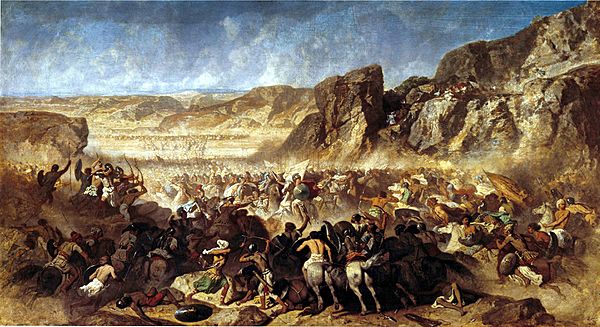Cyrus the Younger facts for kids
Quick facts for kids Cyrus the Younger𐎤𐎢𐎽𐎢𐏁 |
|
|---|---|

Anonymous portrait of a satrap of Asia Minor, around the time of Cyrus the Younger. From a coin of Ionia, Phokaia, circa 478-387 BC.
|
|
| Satrap of Lydia | |
| Reign | 408–401 BC |
| Predecessor | Tissaphernes |
| Successor | Tissaphernes |
| Born | after 424 BC |
| Died | 3 September, 401 BC |
| Dynasty | Achaemenid |
| Father | Darius II |
| Mother | Parysatis |
| Religion | Zoroastrianism |
Cyrus the Younger (Old Persian: 𐎤𐎢𐎽𐎢𐏁 Kūruš; Greek: Κῦρος Kyros; died 401 BC) was a Persian prince and a military leader. He was part of the Achaemenid dynasty, which ruled the Persian Empire. Cyrus served as a satrap (a governor of a province) in Lydia and Ionia from 408 to 401 BC.
He was the son of Darius II, the Persian king, and Queen Parysatis. Cyrus is famous for trying to take the throne from his older brother, Artaxerxes II. He died in 401 BC during this attempt at the Battle of Cunaxa.
Most of what we know about Cyrus comes from a Greek writer named Xenophon. Xenophon wrote a book called Anabasis, which tells the story of Cyrus and the journey of his Greek soldiers after Cyrus died.
Contents
Cyrus's Early Life and Character

Cyrus the Younger was born after 424 BC. He had an older brother, Arsicas, who later became King Artaxerxes II. He also had two younger brothers.
Writers from that time described Cyrus as strong-willed and eager. His brother Artaxerxes was seen as gentler. Xenophon, who knew Cyrus well, praised him highly. He said Cyrus was very modest and respected his elders. He was also excellent at riding horses and loved them.
Cyrus was also a skilled warrior. He was good with a bow and javelin. He loved hunting wild animals, even dangerous ones. Once, a bear attacked him, and he fought it bravely. He was pulled from his horse and got scars, but he killed the bear. He always remembered those who helped him.
Cyrus as Governor and Friend of Sparta
In 408 BC, King Darius II decided to help the Spartans in their war against Athens. He sent Cyrus the Younger to Asia Minor. There, Cyrus became the satrap of Lydia and other areas. He also became the commander of the Persian army in that region.
In Asia Minor, Cyrus met Lysander, a powerful Spartan general. Cyrus saw that Lysander could help him become king of Persia. In return, Lysander hoped Cyrus would help him become the most powerful leader in Greece. So, Cyrus gave a lot of money and resources to Lysander to help Sparta win the Peloponnesian War.
When Cyrus's father, Darius II, became ill, he called Cyrus back to the capital city of Susa. Cyrus gave Lysander all the money from his provinces before he left. Cyrus's mother, Parysatis, wanted him to be the next king. However, Darius chose his older son, Arsicas, who then became King Artaxerxes II. Cyrus remained the satrap of Lydia.
Soon after Darius died, in 404 BC, a man named Tissaphernes accused Cyrus of planning to kill his brother, the new king. Cyrus was arrested, but his mother, Parysatis, helped him. He was pardoned and sent back to his province. This event made Cyrus even more determined to become king.
Cyrus's March Against the King
Cyrus began to gather a large army. He started a fake fight with Tissaphernes over some towns. He also pretended to plan an attack on a mountain tribe called the Pisidians. This allowed him to secretly build up his forces.
In the spring of 401 BC, Cyrus brought all his soldiers together. This army included about 10,000 Greek soldiers, who became known as the "Ten Thousand". He marched from Sardis without telling anyone his real goal. He convinced his Greek soldiers to join him by making big promises.
The Spartans also helped Cyrus. They sent a fleet of 35 ships to Cilicia. These ships helped Cyrus's army pass through the mountains into Syria. They also brought 700 Spartan soldiers to join him. Cyrus had asked the Spartans for help because he had been a good friend to them during their war against Athens.
King Artaxerxes II was warned about Cyrus's plan at the last minute by Tissaphernes. The king quickly gathered his own army. Cyrus marched into Babylonia, where he finally met the king's forces.
The Battle of Cunaxa and Cyrus's Death
The two armies met in October 401 BC at the Battle of Cunaxa. Cyrus had about 10,400 Greek hoplites (heavily armed foot soldiers) and 2,500 peltasts (lightly armed soldiers). He also had a Persian army of about 10,000 men.
Cyrus believed that if he could defeat the king, he would win the battle. He wanted his Greek commander, Clearchus, to attack Artaxerxes directly. But Clearchus worried about his army being surrounded and stayed on the side.
Cyrus then charged directly at Artaxerxes himself. During the fight, Cyrus was killed. Tissaphernes claimed he killed Cyrus. Later, Cyrus's mother, Parysatis, got revenge on those who harmed her favorite son.
After Cyrus died, his Greek soldiers were left without a leader. The Persian army tried to trick them and lead them deeper into enemy territory. But the Greeks managed to fight their way back to the Black Sea. This incredible journey is the main story of Xenophon's Anabasis.
Cyrus's Character: A Leader's Qualities

Xenophon wrote that everyone who knew Cyrus believed he was the most worthy person to be king since Cyrus the Great. Xenophon praised Cyrus for being honest and keeping his promises.
Cyrus was known for being trustworthy. He never lied to anyone. Because of this, people and cities trusted him. Even when he was at war, if Cyrus made a treaty, people knew he would stick to it. He always stood by his friends, even if they faced difficulties.
Cyrus also tried to be better than his friends in being kind and better than his enemies in fighting them. He was said to have prayed, "God grant I may live long enough to repay my friends and punish my enemies with a strong hand."
Cyrus's efforts to reward good behavior earned him the loyalty and love of many followers. He received many gifts, but he was always ready to give them away to others, choosing gifts that would please each person. He would say that a man's best decoration is having noble friends.
Xenophon also described how Cyrus would share special food or wine with his friends. He would send messages saying, "Cyrus says, this is the best wine he has tasted for a long time, that is his excuse for sending it to you. He hopes you will drink it up today with a choice party of friends." He would even share his own food or hay for horses if supplies were scarce. On long journeys, he would talk with his friends in front of crowds, showing how much he honored them.
Images for kids
See also
 In Spanish: Ciro el Joven para niños
In Spanish: Ciro el Joven para niños
- Xenophon
- Anabasis




